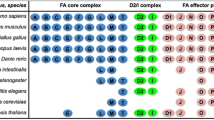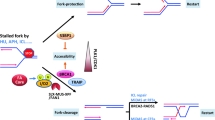Abstract
The protein predicted to be defective in individuals with Fanconi anemia complementation group J (FA-J), FANCJ, is a missing component in the Fanconi anemia pathway of genome maintenance. Here we identify pathogenic mutations in eight individuals with FA-J in the gene encoding the DEAH-box DNA helicase BRIP1, also called FANCJ. This finding is compelling evidence that the Fanconi anemia pathway functions through a direct physical interaction with DNA.

Similar content being viewed by others
References
Joenje, H. & Patel, K.J. Nat. Rev. Genet. 2, 446–457 (2001).
Levitus, M. et al. Blood 103, 2498–2503 (2004).
Strathdee, C.A. et al. Nature 356, 763–767 (1992).
Doherty, A.M. & Fisher, E.M. Mamm. Genome 14, 583–592 (2003).
Cantor, S.B. et al. Cell 105, 149–160 (2001).
Bridge, W.L., Vandenberg, C.J., Franklin, R.J. & Hiom, K. Nat. Genet., advanced online publication 21 August 2005 (10.1038/ng1627).
Meetei, A.R. et al. Nat. Genet., advanced online publication 21 August 2005 (10.1038/ng1626).
Risinger, M.A. & Groden, J. Cancer Cell 6, 539–545 (2004).
Cantor, S. et al. Proc. Natl. Acad. Sci. USA 101, 2357–2362 (2004).
Yu, X. et al. Science 302, 639–642 (2003).
Acknowledgements
We thank the families with Fanconi anemia for cooperating in this study; the treating clinicians (S.E. Ball, R. Barr, J. Burn, L. Pitcher, C. Pellegrini, J.M. Hows and J. Bodurtha) for referring their patients; R.A. Weinberg and B. Klein for providing hTert plasmid; C. van Berkel and E.H. Laghmani for technical assistance; and R. Kanaar for the RAD51C construct. This study was financially supported by the FA Research Fund, the Dutch Cancer Society, the Netherlands Organization for Health Research and Development and the Medical Research Council, UK.
Author information
Authors and Affiliations
Corresponding author
Ethics declarations
Competing interests
The authors declare no competing financial interests.
Supplementary information
Supplementary Fig. 1
FA-J patients and families. (PDF 86 kb)
Supplementary Fig. 2
Candidate-regions for FANCJ. (PDF 73 kb)
Supplementary Fig. 3
Genomic structure of BRIP1/FANCJ. (PDF 116 kb)
Supplementary Fig. 4
FANCJ protein expression in FA-J cell lines. (PDF 226 kb)
Rights and permissions
About this article
Cite this article
Levitus, M., Waisfisz, Q., Godthelp, B. et al. The DNA helicase BRIP1 is defective in Fanconi anemia complementation group J. Nat Genet 37, 934–935 (2005). https://doi.org/10.1038/ng1625
Received:
Accepted:
Published:
Issue Date:
DOI: https://doi.org/10.1038/ng1625
- Springer Nature America, Inc.
This article is cited by
-
Fanconi anemia: current insights regarding epidemiology, cancer, and DNA repair
Human Genetics (2022)
-
Single-molecule imaging reveals replication fork coupled formation of G-quadruplex structures hinders local replication stress signaling
Nature Communications (2021)
-
Dental-craniofacial manifestation and treatment of rare diseases
International Journal of Oral Science (2019)
-
A guanine-flipping and sequestration mechanism for G-quadruplex unwinding by RecQ helicases
Nature Communications (2018)
-
The therapeutic significance of mutational signatures from DNA repair deficiency in cancer
Nature Communications (2018)





